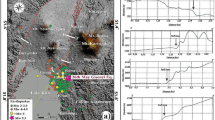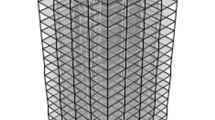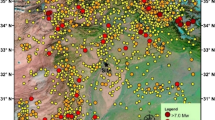Abstract
This paper presents the results of numerical analyses of ground motion in the Red Zone sector of Amatrice hill, violently struck by the 2016–2017 Central Italy seismic sequence. The methodologies used in processing the data to define the numerical model are firstly described. The results obtained from the computational analyses are then presented and discussed by comparing them with experimental data set of weak motion recordings. Computational analyses were performed via both a 2D-numerical FEM model and a pseudo-three-dimensional hybrid model (SiSeRHMap) which develops multispectral maps taking into account topographic effects. Starting from available geological data and geophysical measurements, an original and specific subsoil GIS model was developed and utilised to perform the computational analyses. The preliminary map for fundamental periods computed from the subsoil model is in good agreement with the experimental data. A restricted set of weak ground motions acquired from an accelerometric station located in a reference site was used as input for the numerical analyses, while the signals of the corresponding events recorded at the top of the hill were used as targets in the reliability evaluation analysis of the outputs. In the area of Amatrice hill, which is characterized by a complex geological and topographical context, the reliability analysis shows a good performance of the hybrid model compared to the 2D-FEM model in the prediction of seismic response. Agreement generally was also good with regards to the experimental and computational results, both in relation to the amplitude and to the shape of the spectral amplification that change depending on the hill sector. Considering the predictive reliability of the models, a high amplification, due to topographic effects, was observed for the Red Zone by performing a back-simulation of the 24th August 2016 main shock. The analysis results highlight also that the maximum amplification factors, based on the definition of the Housner intensity, occur in the interval of periods 0–0.5 s covering the fundamental period range of the buildings in this area.
















Similar content being viewed by others
Change history
07 February 2020
This erratum is published as author names were reversed.
References
Assimaki D, Jeong S (2013) Ground-motion observations at hotel Montana during the M 7.0 2010 Haiti earthquake: topography or soil amplification? Bull Seismol Soc Am 103(5):2577–2590
Assimaki D, Gazetas G, Kausel E (2005) Effects of local soil conditions on the topographic aggravation of seismic motion: parametric investigation and recorded field evidence from the 1999 Athens earthquake. Bull Seism Soc Am 95(3):1059–1089
Barani S, Massa M, Lovati S, Spallarossa D (2014) Effects of surface topography on ground shaking prediction: implications for seismic hazard analysis and recommendations for seismic design. Geophys J Int 197:1551–1565
Bard PY (1982) Diffracted waves and displacement field over two-dimensional elevated topographies. Geophys J R Astron Soc 71:731–760
Bard PY, Tucker BE (1985) Ridge and tunnel effects: comparing observations with theory. Bull Seismol Soc Am 75:905–922
Chávez-García FJ, Sánchez LR, Hatzfeld D (1996) Topographic site effects and HVSR. A comparison between observations and theory. Bull Seismol Soc Am 86(5):1559–1573
de Silva F, Ceroni F, Sica S, Pecce MR, Silvestri F (2015) Effects of soil-foundation-structure interaction on the seismic behaviour of monumental towers: the case study of the Carmine Bell Tower in Naples. Rivista Ital. di Geotecnica, special edition "Il ruolo della geotecnica nella salvaguardia dei monumenti e dei siti storici
European Copernicus Agency. https://emergency.copernicus.eu/mapping/ems/satellite-and-aerial-images-reveal-full-extent-destruction-following-italy%E2%80%99s-earthquake. Accessed 27 Dec 2019
Fiorentino G, Forte A, Pagano E, Sabetta F, Baggio C, Lavorato D, Nuti C, Santini S (2018) Damage patterns in the town of Amatrice after August 24th 2016 Central Italy earthquakes. Bull Earthq Eng 16(3):1399–1423
Geli L, Bard PY, Jullen B (1988) The effect of topography on earthquake ground motion: a review and new results. Bull Seismol Soc Am 78:42–63
Grelle G, Bonito L, Revellino P, Guerriero L, Guadagno FM (2014) A hybrid model for mapping simplified seismic response via a GIS-metamodel approach. Nat Hazards Earth Syst Sci 14:1703–1718
Grelle G, Bonito L, Lampasi A, Revellino P, Guerriero L, Sappa G, Guadagno FM (2016) SiSeRHMap v1.0: a simulator for mapped seismic response using a hybrid model. Geosci Model Dev 9:1567–1596
Grelle G, Wood C, Bonito L, Sappa G, Revellino P, Rahimi S, Guadagno FM (2018) A reliable computerized litho-morphometric model for development of 3D maps of Topographic Aggravation Factor (TAF): the cases of East Mountain (Utah, USA) and Port au Prince (Haiti). Bull Earthq Eng 16(5):1725–1750
Hartzell S, Carver DL, King KW (1994) Initial investigation of site and topographic effects at Robinwood Ridge, California. Bull Seismol Soc Am 84(5):1336–1349
Hough SE, Altidor JR, Anglade D, Given D, Janvier MG, Maharrey JZ, Meremonte M, Mildor SL, Prepetit C, Yong A (2010) Localized damage caused by topographic amplification during the 2010 M7.0 Haiti earthquake. Nat Geosci 3:778–782
Housner GW (1952) Spectrum ntensities of strong motion earthquakes. In: Proceedings of the symposium on earthquakes and blast effects on structures. Earthquake Engineering Research Institute
Iervolino I, Baltzopoulos G, Chioccarelli E, Suzuki A (2017) Seismic actions on structures in the near-source region of the 2016 central Italy sequence. Bull Earthq Eng. https://doi.org/10.1007/s10518-017-0295-3
Kottke AR, Rathje, EM (2008) Technical manual for Strata, PEER report 2008/2010, Pacific Earthquake Engineering Research Center College of Engineering, University of California, Berkeley
Kovacs WD, Seed HB, Idriss IM (1971) Studies of seismic response of clay banks. J Soil Mech Found Div ASCE 97(SM2):441–455
Kuhlemeyer RL, Lysmer J (1973) Finite element method accuracy for wave propagation problems. J Soil Mech Found Eng Div ASCE 99(SM5):421–427
Levenberg K (1944) A method for the solution of certain problems in least squares. Quart Appl Math 2:164–168
Marquardt D (1963) An algorithm for least-squares estimation of nonlinear parameters. SIAM J Appl Math 11:431–441
Masi A, Santarsiero G, Chiauzzi L, Digrisolo A, Manfredi V, Prota A, Verderame GM, Ricci P, Del Gaudio C, Di Ludovico M, Cosenza E, Manfredi G, Moroni C, Dolce M (2016) Danni agli edifici in cemento armato di Amatrice in conseguenza del terremoto del 24 agosto 2016: considerazioni preliminari. In: Proceedings of GNGTS 2016 conference, Lecce 22–24 November 2016
Maufroy E, Cruz-Atienza VM, Gaffet S (2012) A robust method for assessing 3-D topographic site effects: a case study at the LSBB underground laboratory. Fr Earthq Spectra 28(3):1097–1115
Maufroy E, Cruz Atienza VM, Cotton F, Gaffet S (2015) Frequency scaled curvature as a proxy for topographic site effect amplification and ground motion variability. Bull Seismol Soc Am 105:354–367
Maufroy E, Lacroix P, Chaljub E, Sira C, Grelle G, Bonito L, Causse M, Cruz-Atienza VM, Hollender F, Cotton F, Bard PY (2018) Towards rapid prediction of topographic amplification at small scales: contribution of the FSC proxy and Pleiades terrain models for the 2016 Amatrice earthquake (Italy, Mw 6.0). In: 16th European conference on earthquake engineering, Thessaloniki, Greece, June 18–21, extended abstract
Milana G, Cultrera G, Bordoni P, Bucci A, Cara F, Cogliano R, Di Giulio G, Di Naccio D, Famiani D, Fodarella A, Mercuri A, Pischiutta M, Pucillo S, Riccio G, Vassallo M (2019) Local site effects estimation at Amatrice (Central Italy) through seismological methods. Bull Earthq Eng. https://doi.org/10.1007/s10518-019-00587-3
Modoni G, Gazzellone A, (2010) Simplified theoretical analysis of the seismic response of artificially compacted gravels. In: Proceedings of the V international conference on recent advances in geotechnical earthquake engineering and soil dynamics, San Diego, USA, Paper No. 1.28a
Molina S, Lang DH, Singh Y (2019) A period-dependent topographic amplification model for earthquake loss estimation. Bull Earthq Eng
Mollaioli F, AlShawa O, Liberatore L, Liberatore D, Sorrentino L (2018) Seismic demand of the 2016–2017 Central Italy earthquakes. Bull Earthq Eng. https://doi.org/10.1007/s10518-018-0449-y
Ohta Y, Goto N (1978) Empirical shear wave velocity equations in terms of characteristic soil indexes. Earthq Eng Struct Dynam 6:167–187
Rai M, Rodriguez-Marek A, Yong A (2016) An empirical model to predict topographic effects in strong ground motion using California small- to medium-magnitude. Earthq Database 32(2):1033–1054
Sánchez-Sesma FJ, Perez-Rocha LE, Chávez-Pérez S (1989) Diffraction of elastic waves by three-dimensional surface irregularities. Part II. Bull Seismol Soc Am 79:101–112
Sitar N, Clough GW (1983) Seismic response of steep slopes incemented soils. J Geotech Eng ASCE 109:210–227
STACEC srl (2017) LSR 2D (Local Seismic Response 2D). User manual. https://www.stacec.com
Wang G, Du C, Huang D, Jin F, Kwan JSH (2018) Parametric models for 3D topographic amplification of ground motions considering subsurface soils. Soil Dyn Earthq Eng. https://doi.org/10.1016/j.soildyn.2018.07.018
Wood CM, Cox BR (2016) Comparison of field data processing methods for the evaluation of topographic effects. Earthq Spectra 32(4):2127–2147
Yokota K, Imai T, Kanemori T (1981) Dynamic deformation characteristics of soils determined by laboratory tests. OYO Tech Rep 3:13–36
Zimmaro P, Stewart JP (2016) Engineering reconnaissance following the 2016 M 6.0 Central Italy Earthquake. Version 1 Geotechnical Extreme Events Reconnaissance Association (Report No. GEER-050), 15 September 2016
Author information
Authors and Affiliations
Corresponding author
Additional information
Publisher's Note
Springer Nature remains neutral with regard to jurisdictional claims in published maps and institutional affiliations.
Rights and permissions
About this article
Cite this article
Grelle, G., Gargini, E., Facciorusso, J. et al. Seismic site effects in the Red Zone of Amatrice hill detected via the mutual sustainment of experimental and computational approaches. Bull Earthquake Eng 18, 1955–1984 (2020). https://doi.org/10.1007/s10518-019-00777-z
Received:
Accepted:
Published:
Issue Date:
DOI: https://doi.org/10.1007/s10518-019-00777-z




